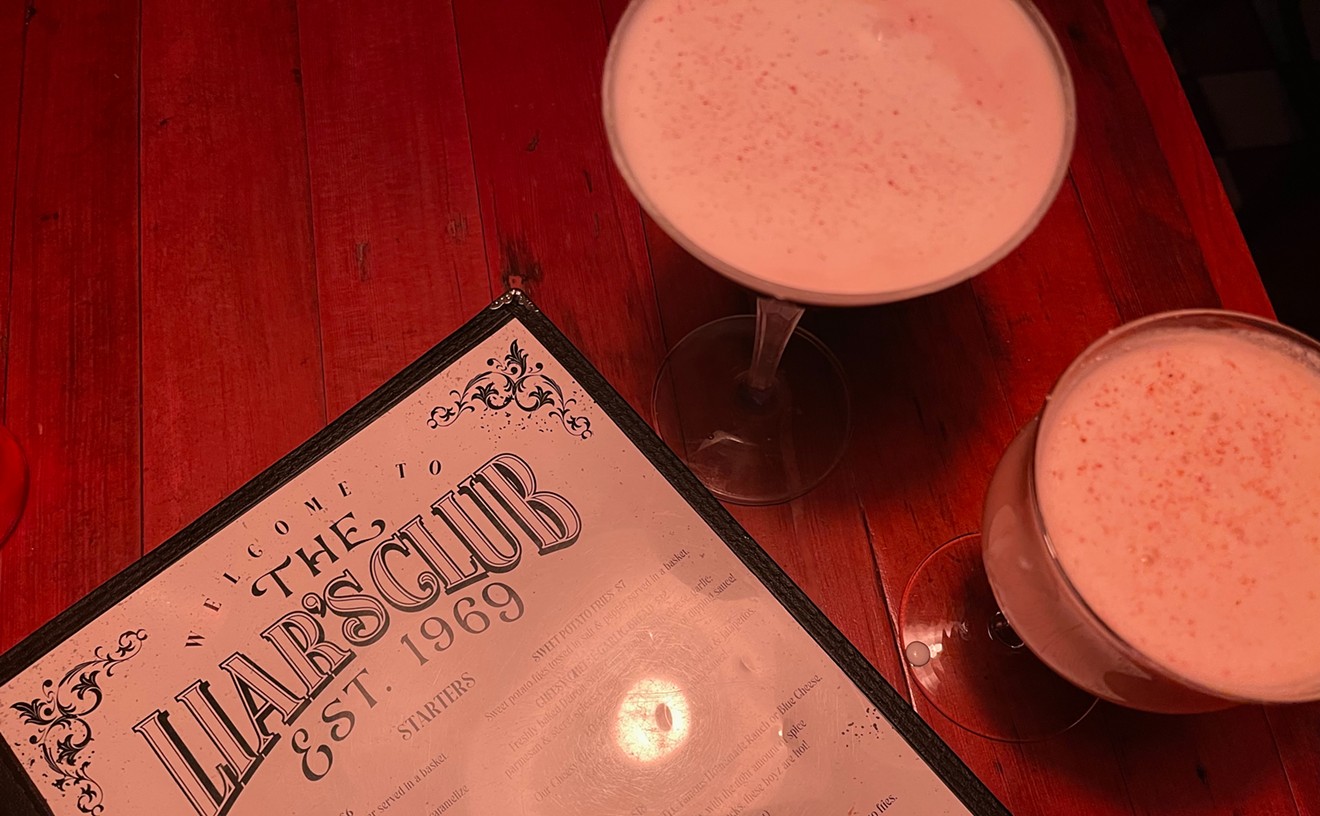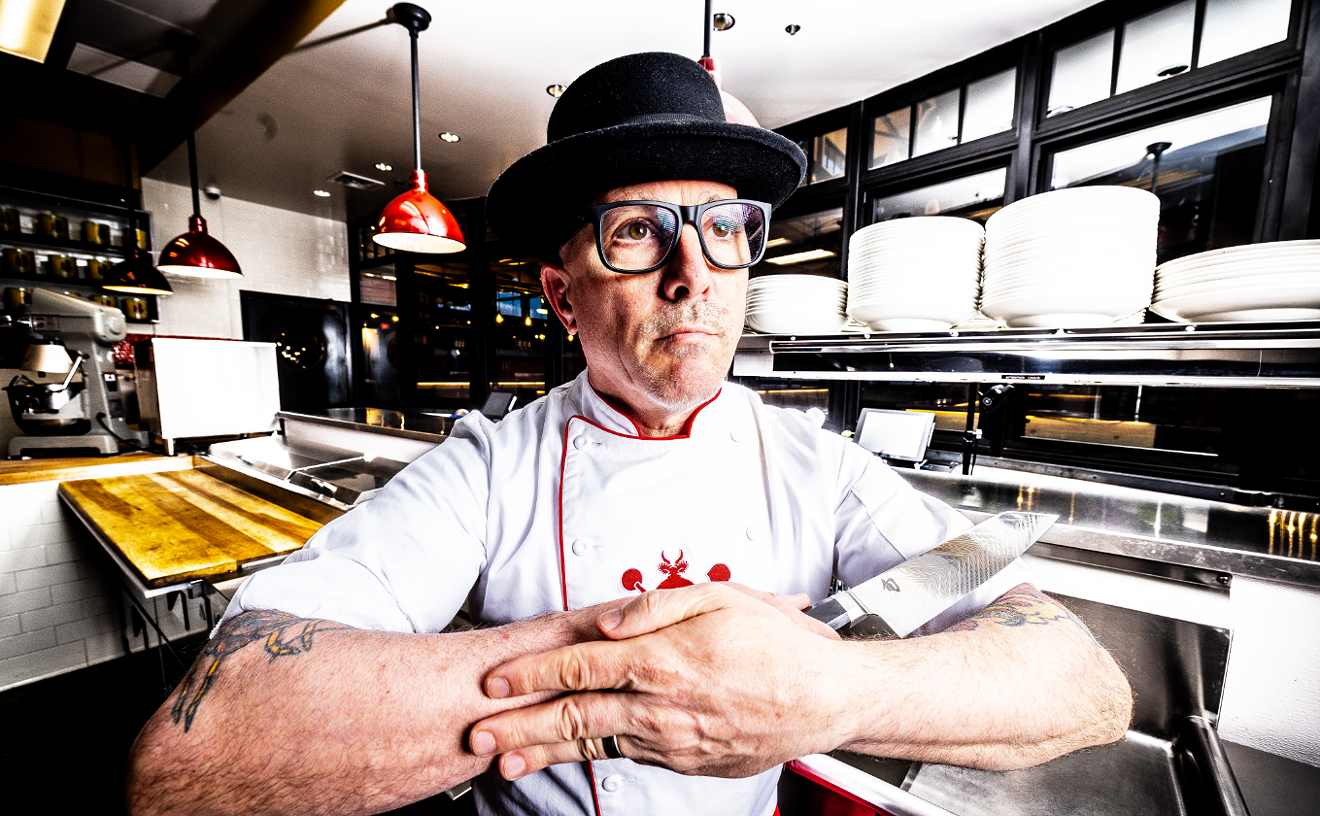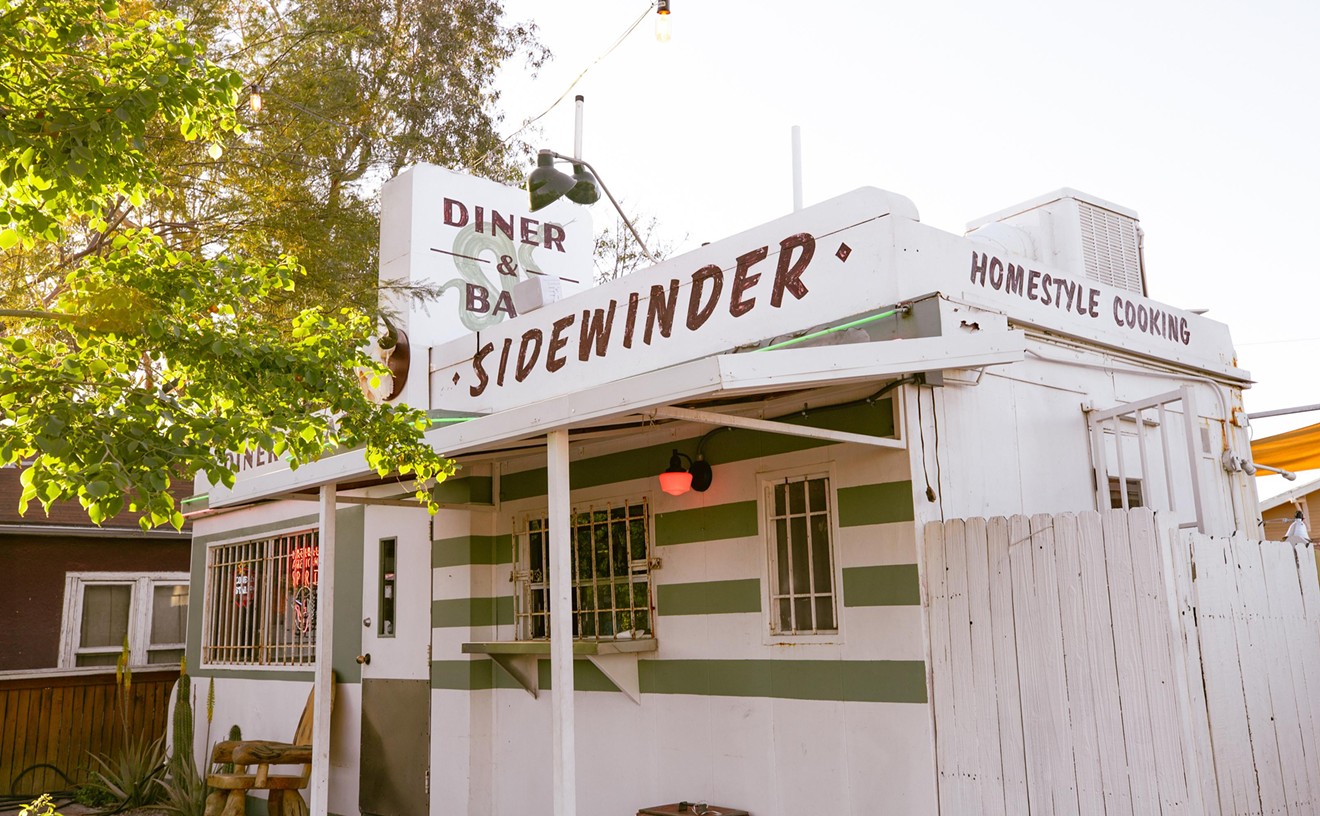On a dry, hot morning in August, in a dirt lot you won't be able to find on a typical map, Gayle Noline stands under a small tent and works the fryer — nothing more than a large saucepan of mega-hot oil — out of which some of the best fry bread you've ever tasted will emerge. The sound of fresh dough being tossed and flattened melds with the sharp sizzle as it hits hot oil to create a pleasing culinary rhythm, barely audible over the sounds of cars whizzing by the Gila River Indian Community municipal center, south of Phoenix. The Sunna Frybread Wagon is preparing for the Friday lunch rush.
It's measurably cooler under the shade of the tent that serves as both mobile kitchen and storefront, but sweat still forms on the young woman's knitted brow as she tosses the dough back and forth between her palms, a process she calls "flapping." She can tell when it achieves just the perfect thickness by the weight, thanks to years of practice. She then drops the disc into a bubbling pot of oil. In a few instants, it emerges as a nearly perfect circle of crispy, golden, deep-fried bread, ready to be topped and consumed. The entire process takes less than two minutes.
"Every tribe has their own way of making it," says Noline, fiancée of one of the Sunna family members, as she rolls around the tangerine-size balls of dough. "But it's all the same. I think that's what connects us to fry bread."
The heart of this whole affair is the "wagon," essentially a trailer with kitchen appliances in it. Hitched to the family's white pickup, the wagon houses a full-size refrigerator and ample counter space for prep and serving. It certainly wouldn't hold up against the food trucks that travel the Valley streets on a regular basis these days, but on the reservation this is a luxury. Inside sit large trays of green and red chili, ground beef, and beans, as well as freshly shredded lettuce, cheese, and tomatoes. Everything besides the frying of the dough takes place in a traditional kitchen, before they head out for the lunch service.
"We cut the lettuce every morning," says Dew Sunna, the family's head cook. "It takes longer but it makes a difference."
Though the wagon started as his mother's dream, Dew is a main source of continued momentum. His mother and father, Gloria and Vernon, now oversee the operation while their children take care of the majority of the daily duties. The entire family takes the small business seriously, but Dew has bigger aspirations and hopes to put the skills he learned while studying at Scottsdale Culinary Institute to good use. Someday, he says, he'd love to own a brick-and-mortar restaurant off the reservation.
Though his goals are a far cry from the current reality, they may not be out of reach in light of one of the food industry's latest trends.
As with many things once considered commonplace — maybe even lowbrow — fry bread recently experienced a rise in interest from the culinary world. Last year, the Valley's own Fry Bread House earned a James Beard Foundation America's Classics award. The foundation's annual awards, often called the "Oscars of the food world," use the America's Classics category to highlight five regional and locally owned restaurants with "timeless appeal."
The national attention on that small family business brought more than a few new customers through the door, says Michael Perry, whose mother, Cecelia Miller, started the restaurant more than a decade ago. Nowadays, it's not uncommon for the place to have a line stretching out the door.
"I didn't realize what it was," Perry admits. "It just seemed like another award, and then this guy told me what it was about . . . I did some looking into it and I realized it was huge."
It might come as a surprise to see fry bread, a dish once viewed as fairground food, emerge as something à la mode, in some cases even swanky. For high-end diners with pocket change to spare, Kai, the state's only Forbes Five Star Award and AAA Five Diamond Award Signature Restaurant, offers a take on the dish. To see more authentic renditions — at a much lower price point — people hunt all over the Valley, searching out one of the locations that serves the dish year-round. (We've done some hunting for you; see the list that accompanies this story.) Fry bread is a dish with many names and styles that sparks heated debates about who's doing it "right" — and where it originates.
As with many ethnic dishes, there's no single answer.
But while fry bread has taken the stage as a veritable culinary delicacy, the dish's beginnings remain a topic of dispute. In the context of the new pan-Indian culture, the dish, which many say was incorporated into the Native American diet in response to relocation and seizure of native lands by the U.S. government, has taken on new meaning as a unifying symbol for native people. Through years of cultural infusion, fry bread has come to hold a prominent place in the lexicon of native food.
Arizona, which ranked third in the United States in Native American and Alaskan population in the 2010 Census, is home to an estimated 22 tribes. Over the past few decades, fry bread has all but replaced alcohol as the scapegoat for continued disparity in Native American health. In a 2008 report, the Centers for Disease Control and Prevention found almost 12 percent of Native American deaths were alcohol-related. But rates of alcohol abuse in the Native American population have fallen closer to those of other ethnic and cultural groups, and, for many, the issue has taken a backseat to a new problem.
Along with Alaska natives, Native Americans have the highest prevalence of diabetes among all racial and ethnic groups in the United States, according to the American Diabetes Association. The most recent figures show that in 1998, more than half the population of the Gila River Indian Community between the ages 15 and 19 suffered from Type II diabetes. Many, including Suzan Shown Harjo, a well-known Native American writer and activist, blame the deep-fried bread.
"If fry bread were a movie, it would be hardcore porn. No redeeming qualities. Zero nutrition," Harijo wrote in a 2005 column in Indian Country Today.
Health consequences aside, many historians maintain the dish's important cultural role. According to Jaclyn Roessel, educational programmer at the Heard Museum in Phoenix, the food represents a sense of home. Despite its complex associations, Rossel, a member of the Navajo community, says fry bread signifies the ability of her people to transform something foreign into something "uniquely Navajo." Food, she adds, is a cultural "a point of pride." Even if it hasn't always been a part of the way of life of a community.
"I think people take for granted nowadays the idea that food does say something about who we are," says Roessel. "[Fry bread] is not a traditional food, but it is an important food."
Like many, Roessel grew up hearing stories of family members who lived through the Long Walk, when the Navajo walked more than 400 miles at gunpoint to Fort Sumner in 1864. Once there, the U.S. Army introduced rations of commodity foods to the displaced people, including flour and lard used to make fry bread. They had no idea the foods would become the makings of a powerful cultural symbol.
It wasn't until the late 1960s and the start of the inter-tribal movement that fry bread emerged as a symbol of pan-Native American culture and unity. After the heavy-handed policies used to assimilate Native Americans to popular culture, community leaders chose for decades to neglect the old ways to avoid further antagonism. The '60s, however, brought a revival of pride in the Native American identity and with it, the rise of the "pow-wow culture."
"When we were kids growing up . . . We weren't allowed to speak our native tongue," recalls Vernon Sunna. "When our oldest kids were in school, it was starting to be taught in grade school. But now they have classes and culture teachers that teach the language."
As the language re-emerged, native people began to feel pride in their culture and food, allowing fry bread the chance to become something bigger than a memory of a painful history.
Freddie Bistoie, a Navajo chef and native foods lecturer who lives in Phoenix, studied cultural anthropology at University of New Mexico and specializes in the study of North American native foods. He points out that native people would not have used animal fat as an ingredient in its own right. More authentic traditional recipes involve baking bread, not frying it in fat or lard. In fact, deep-frying dough would only have been possible after the introduction of brass and copper cookware in the 1600s.
Bitsoie does not view the food as a threat, but rather as a cultural product — the result of decades of cultural infusion and diffusion. In the days when trading posts brought Native Americans and foreign traders together, Bitsoie says, the process of exchanging goods, services, and knowledge could have been when native people were first taught to cook fry bread. Since then, Bitsoie says, the food has become so ingrained in the culture that to try to reject it would be detrimental.
"Fry bread has been a part of a culture for too long," says Bitsoie. "It defined the Native American experience in the United States. It has the ability to kind of have a religion of its own."
The Sunna family has been making and selling fry bread around the Gila River Indian Community for two years. Most days you'll find them in Sacaton, the capital of the community, which is located 45 minutes southeast of Phoenix. Most days they serve their food in parking lots or along the side of the road, towing their trailer to one of the usual spots and serving food 'til it runs out — and it always runs out.
Some believe fry bread should be greasy — use a stack of napkins and you'll still get some on your shirt. Some don't. The Sunnas' bread won't leave your fingers dripping, but it offers just enough greasy flavor to qualify as a guilty pleasure. They don't subscribe to the notion that fry bread — or any of their food, for that matter — should be bland by design. Indeed, their white tepary beans on a bed of freshly fried dough are impossible to forget.
On the reservation and at places like The Fry Bread House, fry bread constitutes more than just a once-a-year treat or an exotic ethnic delicacy. It's everyday food, a common affair and, in many cases, a family effort.
This summer morning, it was Verna Sunna who woke up in the early dawn to make the dough for the day's service. Towing the wagon and working the kitchen fell to younger siblings Jerilyn and Dew, who often receive help from Jerilyn's boyfriend, Anthony. Oldest son Paul helps with the business, while Gloria and Vernon organize and help where needed. Then, of course, there's Gayle frying the bread.
The Sunnas work hard to earn a living in the slow economy. They've gone from selling their popovers (another term for the food) at church and community events to heading out nearly every day to serve lunch somewhere on the reservation. They have a long way to go toward fulfilling Dew's vision, but if serving good food at a fair price still counts for anything, it's undeniable they're doing something right.
"It's a good business," Vernon says, looking around at the wagon and customers. "It's getting good."










